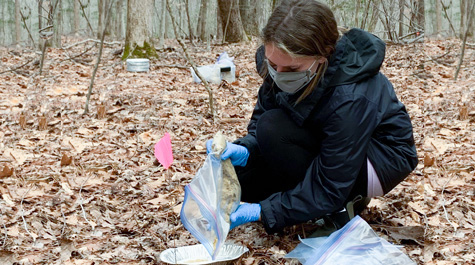Squirrels, nut nutrition & evolution across the ‘landscape of fear’
Everybody knows that squirrels love nuts, but every squirrel knows that some nuts are better than others.
“Walnuts are at the top,” Harmony Dalgleish says. “But they take a lot of handling time. Red oak acorns are really high —and hickories. I think those are the top three.”
Dalgleish, an associate professor in William & Mary’s Department of Biology, is leveraging some squirrelly facts of life for her Population & Community Ecology course, BIOL 417. It’s a lab class being taught largely in person this semester. She explained that nut preference is based on nutrition.
 “There's a set of traits that seeds have that make them more or less valuable to squirrels,” she explained. “A squirrel wants a seed with low tannin and high lipid, like you find in walnuts.”
“There's a set of traits that seeds have that make them more or less valuable to squirrels,” she explained. “A squirrel wants a seed with low tannin and high lipid, like you find in walnuts.”
The class is collaborating on an experiment, what Dalgleish calls a mapping of the ecological “landscape of fear.” The inquiry starts with a set of common-sense essentials about squirrel life and how those fundamentals figure into tree propagation.
“I took a question that I've been thinking about in my research, which was seed dispersal and predation — how predators affects squirrel behavior, and how that impacts tree growth and seed dispersal,” Dalgleish said.
Dalgleish is a botanist; she explains that the squirrel’s habit of caching nuts is an important mechanism of seed dispersal. The nuts the squirrels squirrel away often go uneaten and germinate, becoming tree seedlings. Foraging and caching are different, though.
“Squirrels will forage in areas that are safer, right next to the base of a tree, because the predators won't get them,” Dalgleish explained. “So they'll eat in that patch longer than in one that's further from a tree or in a canopy gap.”
On the other hand, a cache-minded squirrel has a multitude of options: a tree cavity, a corner of a joist in your garage — or a quick hole dug in the predator-patrolled landscape of fear. A squirrel has to balance his worry about hawks catching him out in the open with his fear of another squirrel robbing his cache. A new tree will grow from the nut left in the ground by the squirrel who buried it and, as Dalgleish says, “The other squirrels aren’t going to spend time in risky territory searching for nuts that they didn’t cache out there.”
She presents the hypothesis of the class’s experiment in a nutshell: Squirrels are more likely to cache valuable nuts in riskier, more open areas —and those prized nuts come from tree species with lower shade tolerance. If Dalgleish’s hypothesis is correct, a squirrel will tend to bury the best, most nutritious nuts deeper into the landscape of fear than fast-germinating stuff like a beech nut or a white-oak acorn.
And it could be that those far-flung nuts tend to be from tree species that have evolved the ability to thrive as seedlings out in the open. The tantalizing implication is that the evolution of nut nutrition could be linked to the evolution of shade tolerance.
The venue for the experiment is William & Mary’s College Woods, home to an abundant squirrel population, with enough predators to keep those squirrels from getting complacent. Dalgleish said the first step is to establish the favored foraging locations by setting out trays filled with a sand-sunflower seed mix.
“We set out the sunflower seeds and sand and come back 24 hours later to see how much has been eaten in each of the stations,” she said, adding that measuring consumption will allow the class to identify the areas deemed risky by squirrels.
The next step is artificial caching. Students bury acorns across the landscape of fear that they’ve mapped out with the sunflower observation.
“We’ve actually glued magnets to the acorns,” Dalgleish said. “And then we come back with a magnetometer. We won’t even have to dig up the acorns. The hypothesis is that the acorns we place in the riskier area, where foraging activity was low, will stay there longer.”
Students will begin analyzing data next week from their foraging inquiry. The College Woods study was actually the second phase in Dalgleish’s experimental plan.
“The goal was to do a greenhouse study, then a field study,” she said.
The class set out to germinate 18 different tree species in the ISC greenhouse, then measure the shade tolerance of the seedlings. The class learned a great deal about light curves and photosynthesis — but most of the seeds failed to germinate.
“And that’s a bummer when you’re working with students,” Dalgleish said. “But I looked at them and said, ‘This is real science.’”
 Skip to main content
Skip to main content

